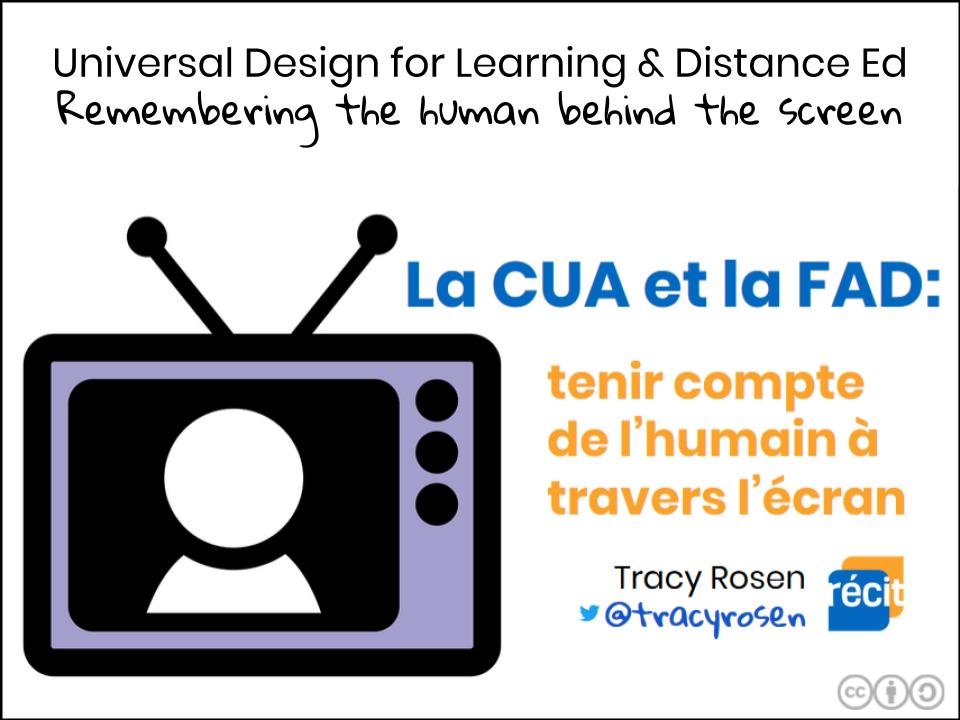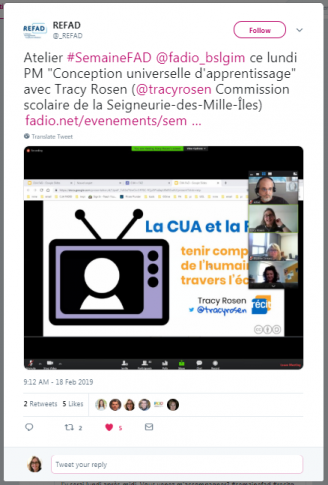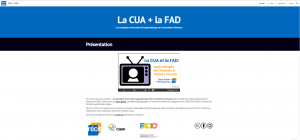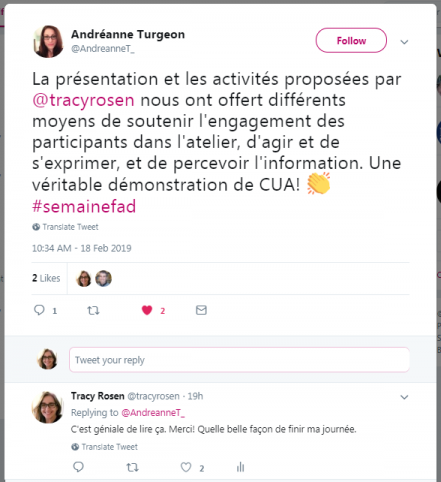Universal Design for Learning…Online.

About a month ago, I was invited to speak about Universal Design for Learning (UDL) at an online conference during the Semaine de la Formation à Distance, organized by FADIO. That week is happening this week and I presented yesterday.
As you can see in the tweet below, I presented in French. I called my presentation La CUA et la FAD: tenir compte de l’humain à travers l’écran (Loosely translated as UDL and distance education: considering the human through the screen. Link to tweet: )

I had two goals:
- To introduce the topic by talking a little about how I discovered the importance of UDL and other inclusive frameworks for my practice
- To allow my participants to work in small groups and / or alone to experience and reflect on some activities that I designed using those frameworks.
I actually had a third goal – it was to not explicitly present the frameworks in detail. I wanted to allow participants to experience learning that was designed using the frameworks. I decided that anyone could go read the frameworks if they wanted more detail and so I included them as extra resources.
I used a website to house all of my materials as well as the instructions for the experiential parts of the presentation. Those activities were sandwiched in between different parts of my presentation and feedback conversations. 
So, how did it go?
First off, I was out of my comfort zone on a few different levels.
- My audience was a mix of teachers, instructors, consultants and administration from public schools but also CEGEPs and Universities – not my typical audience.
- I was presenting entirely in French – not my first language.
- The conference platform was Zoom and this was my first time using it
To add to that, there were two uncomfortable moments:
- A participant was persistent about her belief that presentation was missing information and I allowed that conversation to last a bit longer than it should have.
- At one point, there was a somewhat sexist comment made by one of the participants towards other participants.
I didn’t manage those conversations well. I think that working entirely in French on an unfamiliar platform didn’t help. Luckily, they didn’t last all that long and I don’t think they detracted all that much from the rest of the session.
Back to how did it go?….I received verrrrrrrry mixed reviews!
Ranging from – this remains very superficial. Where are your schema and frameworks? Do you have any meat to add to your presentation? To this:
(Loose translation: The presentation and activities that Tracy proposed offered us different ways to sustain participant engagement, to act and express ourselves, and to access information. A true demonstration of UDL. Link to tweet)
Much of the response I received was positive and there were also others who left during the presentation.
So. What do I take away from these mixed responses?
I believe that the best way to learn about new classroom practice is to experience new classroom practice. I have seen how this kind of experiential learning can have an impact on practice many times. But that does not mean that is the only way I need to interact with participants.
I could say, oh well, you can’t please everyone. BUT. Actually, that wouldn’t be very UDL of me, would it?
For some people, they need to see those frameworks before experiencing them in order to experience them and make connections. For others, they make the connection to theory through the experience. And for others, they might make the connection to theory afterwards. All of this lies in the area of motivation and engagement- the Why am I learning this? principle of UDL.
I had placed the frameworks in an extra resources section of the website and included the option of visiting the extra resources section when participants completed activities but did not offer them as a specific choice during one of the activities.
In my presentation, I talked about how the teacher’s task is to create an environment where instruction of content is well-balanced with learner needs. I discovered that I didn’t quite do that here.
Each time I work with teachers and other educators, I learn something new. In the future, I am going to explicitly offer detailed views of frameworks as a choice during the small group activities.
(And I am also going to reflect on managing uncomfortable conversations, regardless of the setting.)
One Reply to “Universal Design for Learning…Online.”
Comments are closed.


[…] magic of online stations (which are very doable with breakout rooms in Zoom or Via ‘ateliers’ and even manageable with multiple Meet rooms) is the same as the magic […]